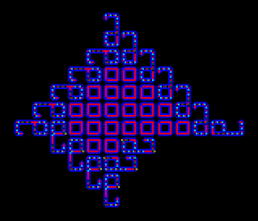Monday, May 05, 2025
Links for "Self-Reproduction and Open-Ended Evolution" Lecture
Robot Self-replication
Cornell Creative Machines Lab: Self replication
Soft Robotics Evolution
An implementation of Von Neumann's Self_reproducing Automata.

Self-Reproducing Loops: from Langton's to Evoloop. Hiroki Sayama's Website and demos.
Self-reproducing loops
Langton's Loop Applet .

Self-reproducing Xenobots.
autocatalytic networks
Lack of evolvability in self-sustaining autocatalytic networks
Darwinian properties and their trade-offs in autocatalytic RNA reaction networks
The invention of writing on Rapa Nui (Easter Island)
Language at the End of the WorldÇ The undecipherable rongorongo script of Easter Island
Cornell Creative Machines Lab: Self replication
Soft Robotics Evolution
An implementation of Von Neumann's Self_reproducing Automata.

Self-Reproducing Loops: from Langton's to Evoloop. Hiroki Sayama's Website and demos.
Self-reproducing loops
Langton's Loop Applet .

Self-reproducing Xenobots.
autocatalytic networks
Lack of evolvability in self-sustaining autocatalytic networks
Darwinian properties and their trade-offs in autocatalytic RNA reaction networks
The invention of writing on Rapa Nui (Easter Island)
Language at the End of the WorldÇ The undecipherable rongorongo script of Easter Island
Labels: #Brenner, #open-endedEvolution, #self-reproduction, #Turing, #VonNeumann, Class Links
Life as a cascade of Machines
"we first discuss the micro-cascade proposed by Leibniz, which describes how the self-reproducing machine of the cell is built of smaller submachines down to the atomic scale. In the other direction, we propose that a macro-cascade builds from cells larger, organizational machines, up to the scale of the biosphere. The two cascades meet at the critical point of 103 s in time and 1 micron in length, the scales of a microbial cell. We speculate on how this double cascade evolved once a self-replicating machine emerged in the salty water of prebiotic earth". Full paper at PNAS.
![]()
Labels: #life, #self-reproduction, #VonNeumann
Evolution of complexity through regulatory variation at a single gene
"Life history traits evolve to optimize an organism’s survival and reproductive output in response to natural selection (7). They are complex traits—e.g., size at birth, growth pattern, and age at maturity—that combine variation in physiology, development, and behavior to maximize fitness in a particular environment. Due to their complexity, variation in life history traits is expected to involve multiple genes (polygenic) (5), a genetic architecture that is particularly difficult to study given the statistical challenge of linking the effect of multiple low-effect genes to phenotypic variation. [...] The study of Verta et al. (6) revealed vgll3’s master control over multiple regulatory pathways, supporting the notion that it acts indeed as a hub gene." Full report at PNAS. Sell also the paper by Verta et al.
Related studies are reported by Rosvall, summarizing work identifying regulation of behavior and morphology driven by testosterone, which is formed via complex enzymatic pathways, but can be controlled by a single gene in birds, resulting in impressive morphological and behavioral diversity.


![]()


Labels: #evolution, #Gene

